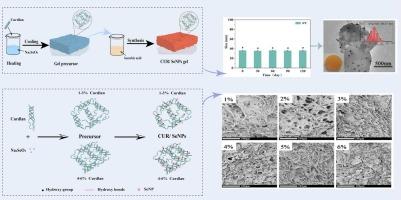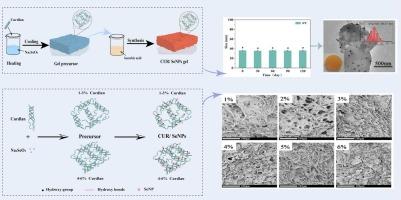基于curdlan的SeNPs复合水凝胶的原位合成与评价:稳定性和缓释效果
IF 9.8
1区 农林科学
Q1 CHEMISTRY, APPLIED
引用次数: 0
摘要
本研究以Curdlan (CUR)水凝胶为模板稳定硒纳米颗粒(SeNPs),重点研究其稳定机制、储存稳定性、释放行为和消化稳定性。结果表明,cu稳定的SeNPs呈球形,分散均匀,平均尺寸为36.0 ± 2.5 nm。增加CUR浓度提高了体系的持水能力,降低了孔隙度,形成了更致密的网络结构,有助于稳定senp。傅里叶变换红外(FT-IR)和流变学分析表明,氢键对SeNPs的稳定性有显著影响。当CUR浓度为4 %时,形成最优的网络结构。在4 °C时,SeNPs保持均匀分散120 天,平均尺寸为36.0 ± 0.5 nm。CUR/SeNPs水凝胶表现出缓释,从模拟胃液中的1.68 %增加到肠液中的18.19 %。释放行为符合Korsmeyer-Peppas模型。此外,CUR/SeNPs水凝胶可以有效清除DPPH自由基,且其效率随硒释放量的增加而增加。本文章由计算机程序翻译,如有差异,请以英文原文为准。


In-situ synthesis and evaluation of Curdlan-based SeNPs composite hydrogel: effect of stability and sustained release
This study used Curdlan (CUR) hydrogels as templates to stabilize selenium nanoparticles (SeNPs), focusing on their stabilization mechanisms, storage stability, release behavior, and digestive stability. Results showed that CUR-stabilized SeNPs were spherical, uniformly dispersed, and had an average size of 36.0 ± 2.5 nm. Increasing CUR concentration improved the system's water-holding capacity, reduced porosity, and formed a denser network structure, which helped stabilize the SeNPs. Fourier-transform infrared (FT-IR) and rheological analysis indicated that hydrogen bonds contributed significantly to SeNPs stability. The optimal network structure formed at 4 % CUR concentration. At 4 °C, the SeNPs remained uniformly dispersed for 120 days with an average size of 36.0 ± 0.5 nm. The CUR/SeNPs hydrogel showed sustained release, increasing from 1.68 % in simulated gastric fluid to 18.19 % in intestinal fluid. The release behavior conforms to the Korsmeyer-Peppas model. Moreover, CUR/SeNPs hydrogel effectively scavenges DPPH radicals, and its efficiency increases with the amount of released selenium.
求助全文
通过发布文献求助,成功后即可免费获取论文全文。
去求助
来源期刊

Food Chemistry
工程技术-食品科技
CiteScore
16.30
自引率
10.20%
发文量
3130
审稿时长
122 days
期刊介绍:
Food Chemistry publishes original research papers dealing with the advancement of the chemistry and biochemistry of foods or the analytical methods/ approach used. All papers should focus on the novelty of the research carried out.
 求助内容:
求助内容: 应助结果提醒方式:
应助结果提醒方式:


